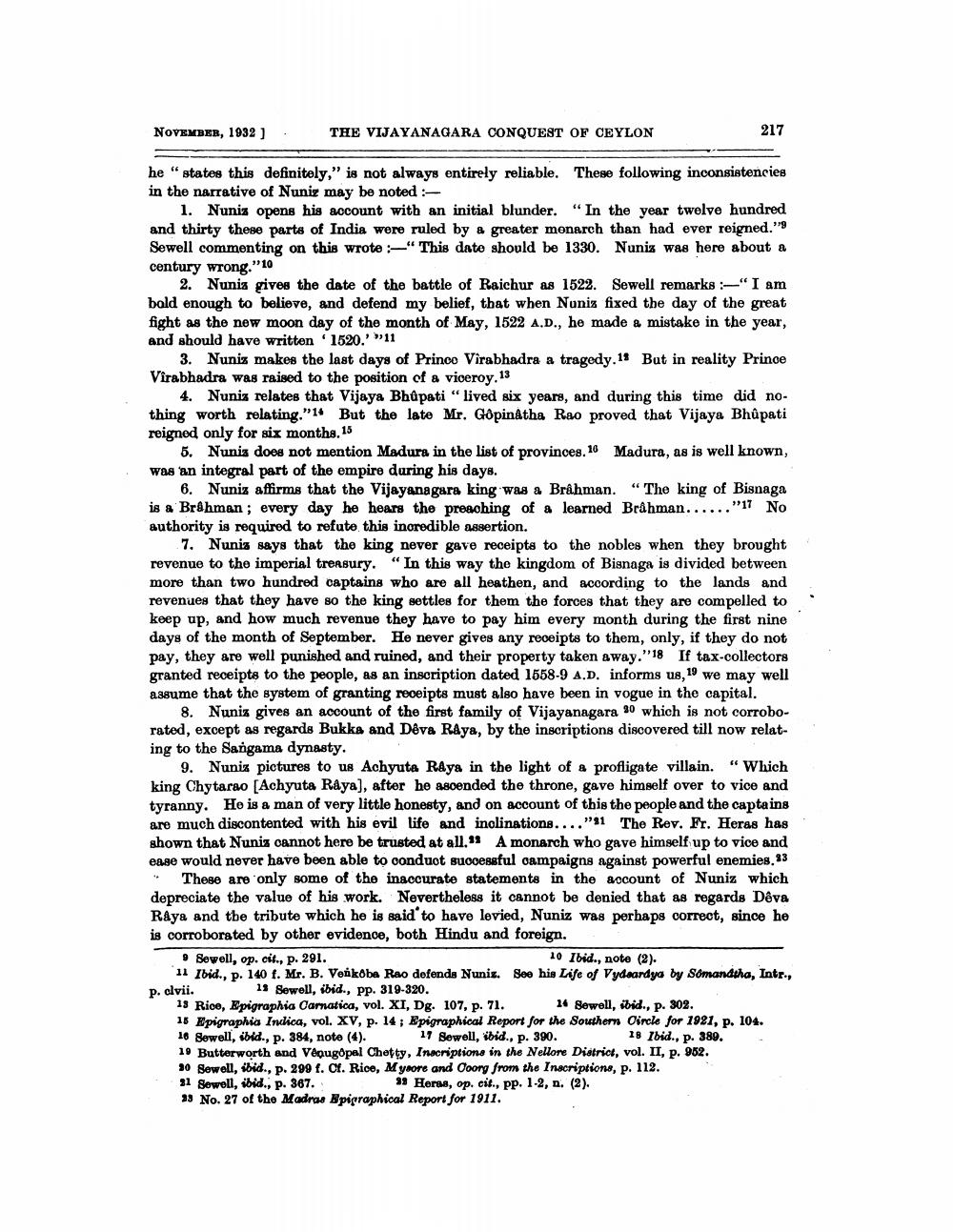________________
NOVEMBER, 1932).
THE VIJAYANAGARA CONQUEST OF CEYLON
217
he "states this definitely," is not always entirely reliable. These following inconsistencies in the narrative of Nuniz may be noted >
1. Nuniz opens his account with an initial blunder. "In the year twelve hundred and thirty these parts of India were ruled by a greater monarch than had ever reigned.'' Sewell commenting on this wrote :-"This date should be 1330. Nunix was here about a century wrong."10
2. Nunis gives the date of the battle of Raichur as 1522. Sewell remarks "I am bald enough to believe, and defend my belief, that when Nunix fixed the day of the great fight as the new moon day of the month of May, 1522 A.D., he made a mistake in the year, and should have written '1520.' "11
3. Nunis makes the last days of Prince Virabhadra a tragedy. 1° But in reality Prince Virabhadra was raised to the position of a vioeroy. 13
4. Nunis relates that Vijaya Bhậpati "lived six years, and during this time did nothing worth relating."14 But the late Mr. Gopinatha Rao proved that Vijaya Bhûpati reigned only for six months.15
5. Nunis does not mention Madura in the list of provinces. 10 Madura, as is well known, was an integral part of the empire during his days.
6. Nuniz affirms that the Vijayanagara king was a Brâhman. "The king of Bisnaga is a Brahman; every day he hears the preaching of a learned Brahman......"17 No authority is required to refute this incredible assertion.
7. Nunis says that the king never gave receipts to the nobles when they brought revenue to the imperial treasury. "In this way the kingdom of Bisnaga is divided between more than two hundred captains who are all heathen, and according to the lands and revenues that they have so the king settles for them the forces that they are compelled to keep up, and how much revenue they have to pay him every month during the first nine days of the month of September. He never gives any receipts to them, only, if they do not pay, they are well punished and ruined, and their property taken away."18 If tax-collectors granted receipts to the people, as an inscription dated 1558-9 A.D. informs us, we may well assume that the system of granting receipts must also have been in vogue in the capital.
8. Nuniz gives an account of the first family of Vijayanagara 30 which is not corroborated, except as regards Bukka and Deva Raya, by the inscriptions discovered till now relating to the Sangama dynasty.
9. Nunix pictures to us Achyuta Raya in the light of a profligate villain." Which king Chytarao [Achyuta Raya), after he ascended the throne, gave himself over to vice and tyranny. He is a man of very little honesty, and on account of this the people and the captains are much discontented with his evil life and inclinations...."91 The Rev. Fr. Heras has shown that Nunis cannot here be trusted at all." A monarch who gave himself up to vice and eage would never have been able to conduot successful campaigns against powerful enemies.
These are only some of the inaccurate statements in the account of Nuniz which depreciate the value of his work. Nevertheless it cannot be denied that as regards Dêva Raya and the tribute which he is said to have levied, Nuniz was perhaps correct, since he is corroborated by other evidence, both Hindu and foreign. 9 Sewell, op. cit., p. 291.
10 Ibid., note (2). 11 Ibid., p. 140 1. Mr. B. Vonkoba Rao defenda Nuniz. See his Life of Vydwardya by Somandsha, Intr., p.clvii.
13 Sewell, ibid., pp. 319-320. 18 Rice, Epigraphia Carnatica, vol. XI, Dg. 107, p. 71. 14 Sewell, ibid., p. 302. 15 Epigraphia Indica, vol. XV, p. 14; Epigraphical Report for the Southern Oircle for 1921, p. 104. 16 Sewell, ibid., p. 384, note (4). 17 Sewell, ibid., p. 390.
18 Ibid., p. 389. 19 Butterworth and Venugopal Chetty, Inscriptions in the Nellore District, vol. II, p. 962. 30 Sewell, ibid., p. 299 f. OY. Rice, Mysore and Coorg from the Inscriptions, p. 112. 31 Sowell, ibid., p. 367.
99 Heras, op. cit., pp. 1-2, n. (2). 33 No. 27 of the Madras Epigraphical Report for 1911.




